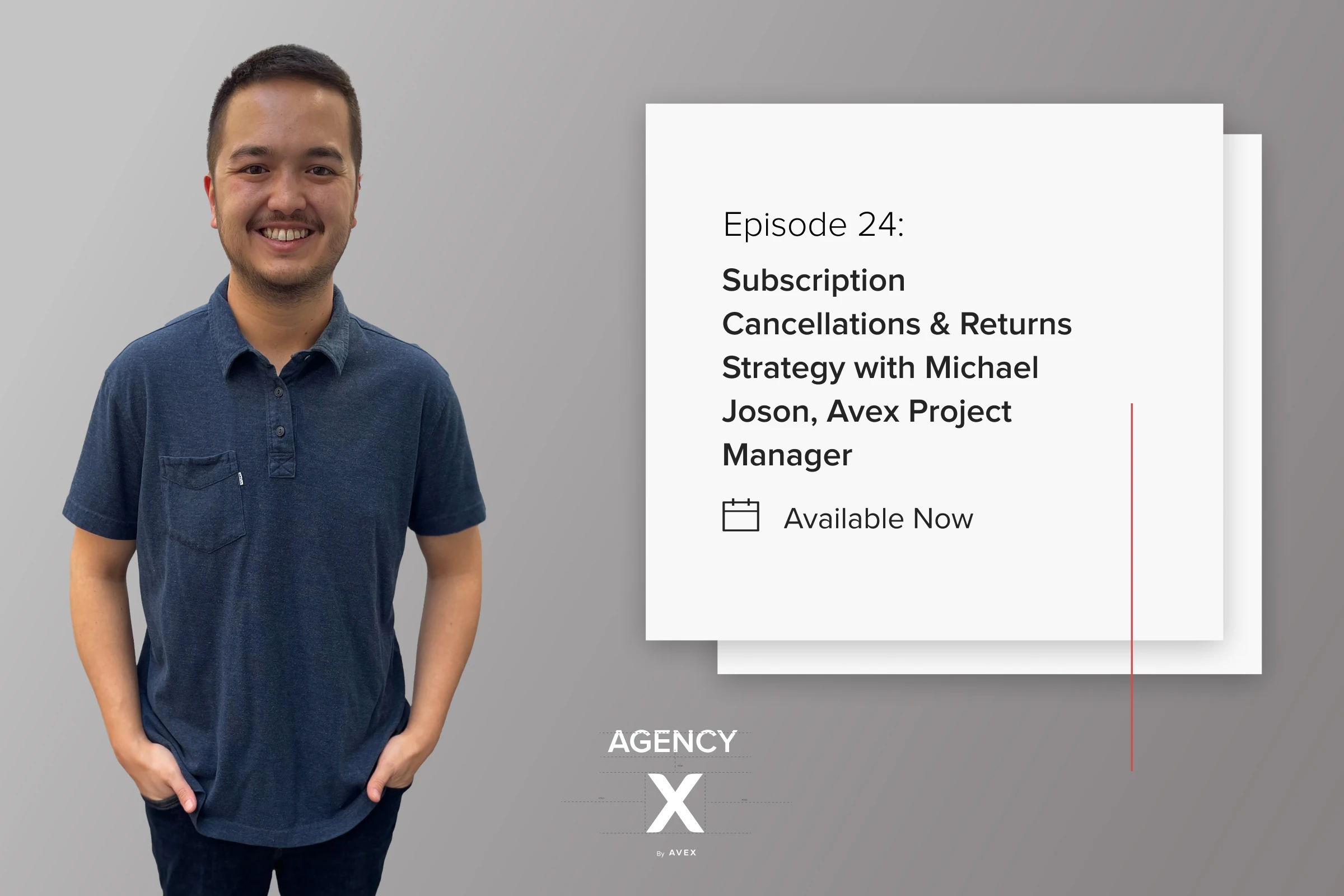Agency X Podcast: Subscription Cancellations & Returns Strategy with Michael Joson, Avex Project Manager

Quick Summary Wondering how best to handle common issues that awry when sending subscriptions out to those VIP customers? Look no further.
In this episode, we have a special guest: our very own project manager Michael Joson! Michael chose to talk about subscriptions because his last role was in customer support at a cannabis products company in California. Handling the shipment of large glass pieces created some chaotic scenarios for that company, and Michael made sure the customers stayed happy.
In the highlights from the episode, Michael and David explain how to focus on customer retention when dealing with weekly or monthly packages, especially when the products are perishable or easily breakable.
Best Refund Practices For Subscriptions
Michael 2:51 - 4:16
In terms of cancellations for subscriptions, you have to be very flexible, both from the perspective of canceling them and changing or pausing the plan halfway through or just any term during it. Ours was monthly and it was indefinite. However, you could buy a three, six, or at one point a 12-month package as well that discounted it just a little bit. The downsides of those for clients and customers was that it potentially couldn't be refunded the same way. Let's say you had a 12-month membership (and this is actually why these don't exist anymore with this company) you can only do a return on a credit card for six months at most on some credit cards but it's usually 90 days. Anything past that is not refundable in terms of cash unless you go out of your way to write a check or send a Venmo or PayPal, which is not typically best business practice. So when you sign up for a prepaid plan, you are agreeing to this much. And if you do cancel somewhere throughout it, if you're unable to be refunded, you'll only be issued a store credit so they weren't completely left hanging. That had some positive ramifications on their cancellation process. Generally, they understood that because if you made an Amazon purchase that long ago, they're not going to be able to help you with cash either. Fortunately, that's been set as an expectation.
When You Should Cut Off Returns
Michael 4:16 - 4:47
In terms of the policy, I recommend for any subscription service no more than two weeks of a return window. The reason for that being many subscription services have consumables in them, those are likely going to be used before the package gets back to you even if there's breakage or something on another item. And then you're out that much for whatever that item that is missing is unless you want to go back to the customer and argue about what was in the box, which if you're trying to retain the subscriber is generally not the best way to go.
Most Common Reasons For Returns or Cancellations
Michael 8:18 - 9:09
If I were a customer paying for three months at a company and two of the three items are right broken, my confidence in that company would be eroded. So that's what ended up happening with I would say the vast majority felt like they either weren't getting what they asked for or came in a bad condition. And then in addition to that, and this a standard for any subscription service, it's the people that didn't realize they're still on it. So you're going to get the people that come in and go, I was charged today, I can't pay for this, I need to cancel and get a refund right away. So the big thing there is timing, so setting expectations with your customers on when refunds can be issued, when things can be canceled. Do not charge a fee when canceling a subscription or have a minimum term because it simply will not maintain customers. Having tried that, that was not a good business model in terms of keeping customers confident in the company.
Diversity In Products: When You Should and Shouldn’t Have It
Michael 9:16 - 10:33
I have two words in subscriptions that send chills down my spine, and they are assorted colors. The reason I bring that up is I'm seeing a picture on the website of a blue, fill in the blank, let's say t-shirt, you get a red one because it says assorted colors are available. That is a difficult conversation to resolve with the customer. Because in that case, it does require, Okay, maybe we have that in stock. If we do, I'm going to have to have you send back the original shirt, you pay the shipping and then we're going to ship this back to you. And at that point, it is usually a no in the customer not wanting to go through that process. So being careful choosing which items you use every month. It could be if it's a similar color or different colors between items, they're not going to be happy. If it's a similar design as a month before, they're not going to be happy. We reused one mold on glass, I would say a year and a half in between the two of them, it was a very large gap because creating molds is tens of thousands of dollars to do so. And we redid the entire outside of it, redid an attachment on it, and we lost hundreds, maybe thousands of subscribers, because it looks similar to a month before. So that's another thing to bear in mind is the quality and diversity of the products has to continue.
See how we launch & scale brands on Shopify Plus with a data-backed approach
Staying Consistent With Support Tickets
Michael 13:13 - 14:01
When I came in, there was no macro for really anything that was consistent for responding to customer support tickets. And because of that one person may get a return one month over one issue and then their friend for the same issue doesn't get a return approved. Its dicey keeping in that consistent messaging is good. I tend to go through and if say it's someone with a store or issue that happened to be a subscriber, you treat them a little more attentively, and vice versa. Because you know, they have more than one stream of revenue coming in. It's pretty hard to convince somebody to keep a subscription once they've made up their mind, largely because it's around budgeting their monthly expenses. But what I would do is really just explain if it were from an issue that I'm handling as a manager, we're going to take care of you. I would say things like this next month's drops are going to be awesome. Check it out before you pay to make sure that's what you'd like.
Your Smaller Items Are Worth More Than You Think
Michael 14:37 - 15:31
If it were from breakage, you get your replacement but maybe I throw in a pack of rolling papers or something tiny. Those little additions sometimes kept people from going. If you have extra inventory subscription service from the month before, whether it be a consumable item or something tiny like a key chain, throw it in there with the replacement item. Your items are likely going to just go to waste sitting in the warehouse, and that will help you maintain a customer base. If people say they are going to leave, we send them a couple of stickers and the lighter and the replacement item, and they stay. So just going out of your way to make them happy does not have to be a monetary incentive, it can just be showing that you are paying attention and care a little bit more than just a formal, Here's a standard decision, you're getting just that item sent to you, goodbye. That is the intent of that mentality, they're not looking forward, because coming from a customer base and subscription, they're expecting a relationship with you.
Setting Expectations For The Holidays
Michael 18:46 - 19:22
So what we did one year was promised that if you purchased by the first week in December, be there by Christmas, it didn't happen. not our fault. It was long to do the mail service and all the issues with that. The following year, we made an announcement that it's not guaranteed at any date, it just said make your purchase, we cannot guarantee Christmas delivery, we're experiencing delays, it may be longer than normal. And the sales actually increased, they did not drop off from the year before. And that was because you set an expectation, and I had far fewer support tickets come in that year because they knew that there were going to be delays. So communicating all that ahead of time will absolutely help.
Using Route For Resending Products
Michael 23:11 - 24:07
We implemented a program called Route. They take care of the shipping damaged or lost items on their side. You charge an extra fee to the customer, we're talking like $1, it's not anything really significant, and it gives the customer peace of mind that if it arrives broken, slightly damaged, missing, they can go to Route through a portal, file a claim for it, Route goes to us and places an actual order, and then that went through to the customer as a new shipment. So having potentially a third party helping you with that helped me. I was pulling my staff before to physically pack boxes and go through steps like that. It's just simply inefficient. So what would happen is it comes in as a shipment from the store, it goes to my warehouse team, we tag it with its customer service, just a little heads up and throw in some extra items. Apps are going to help for sure.
Learn more about subscriptions and the customer support industry by listening to the full episode here.



